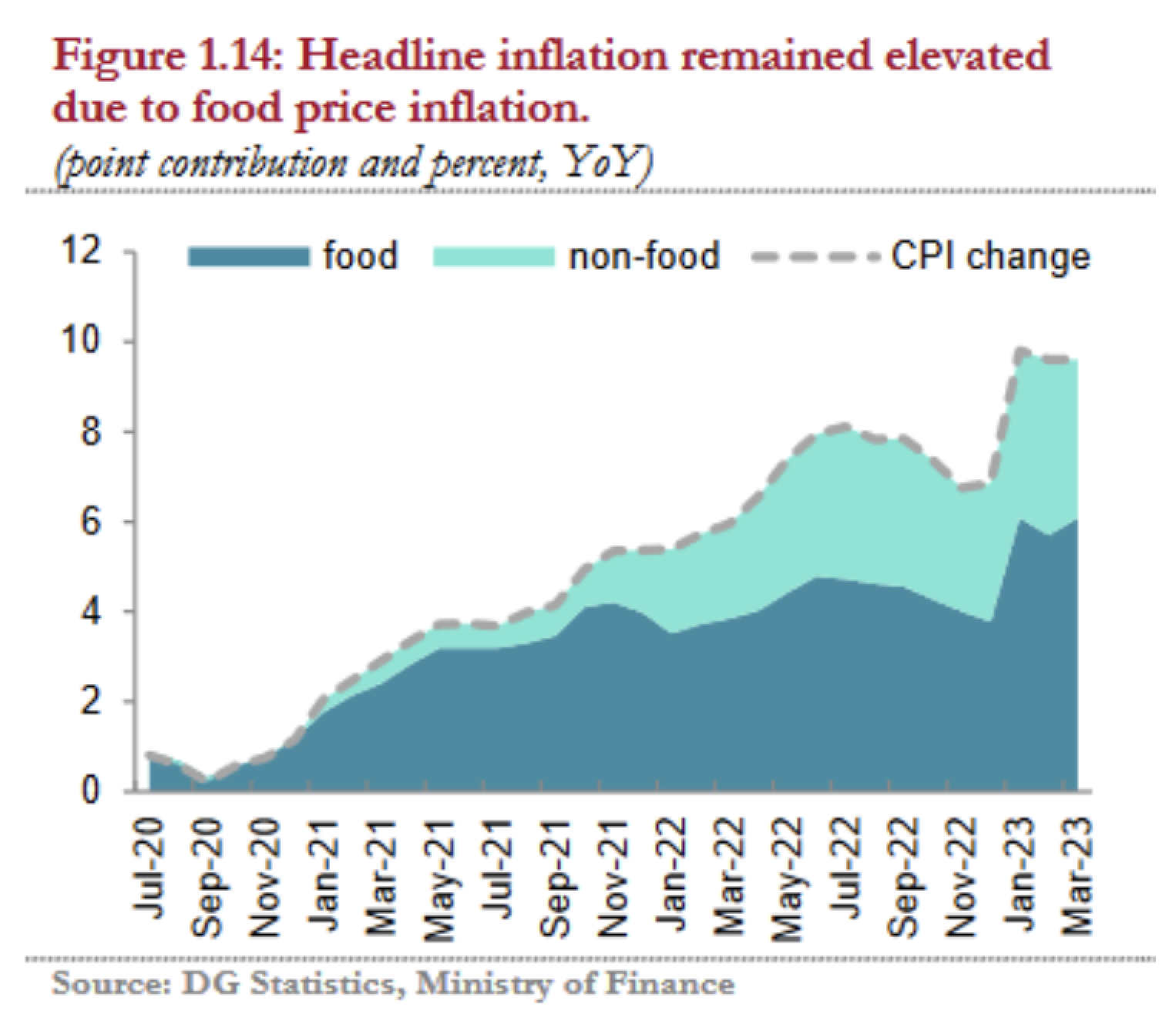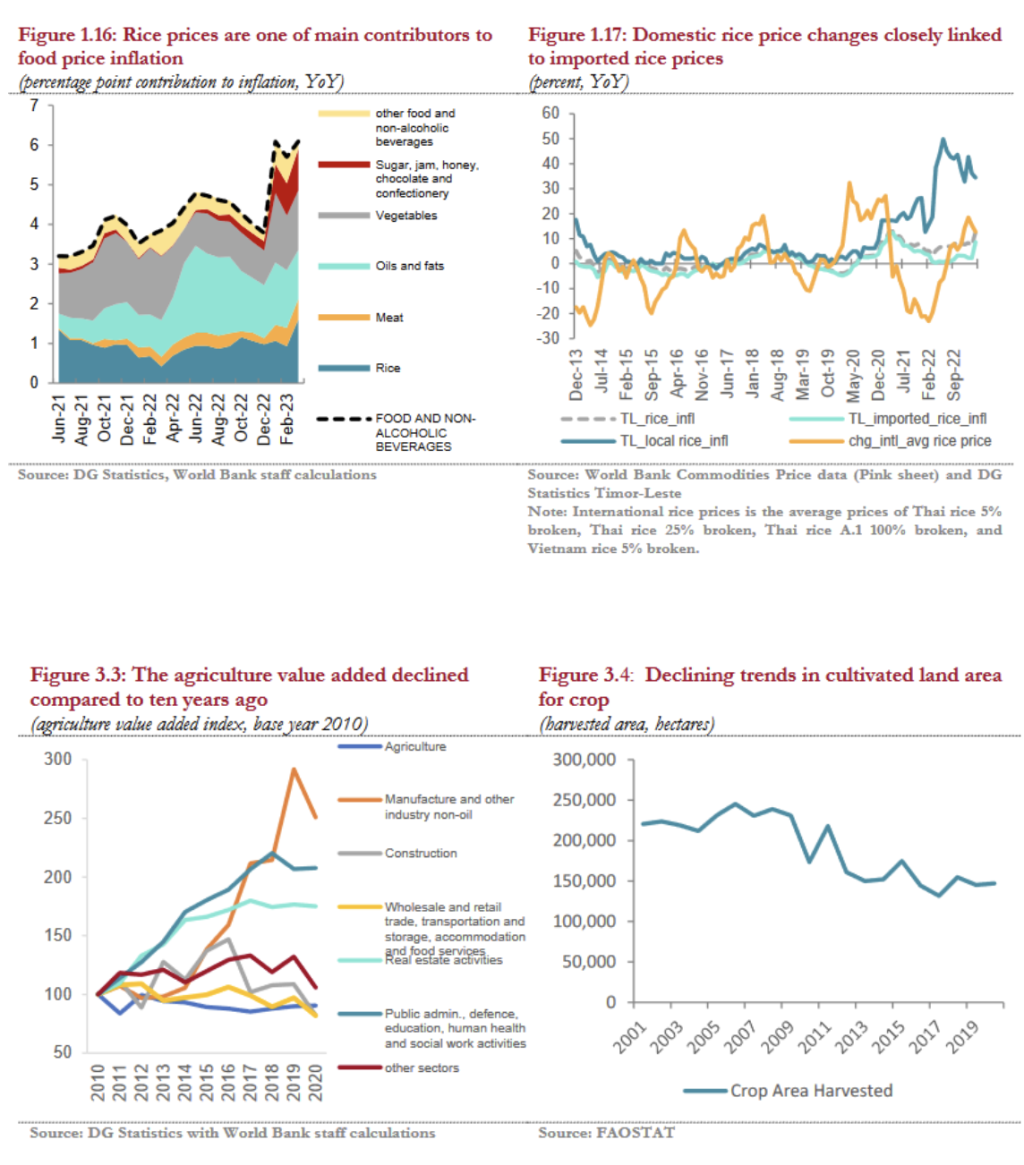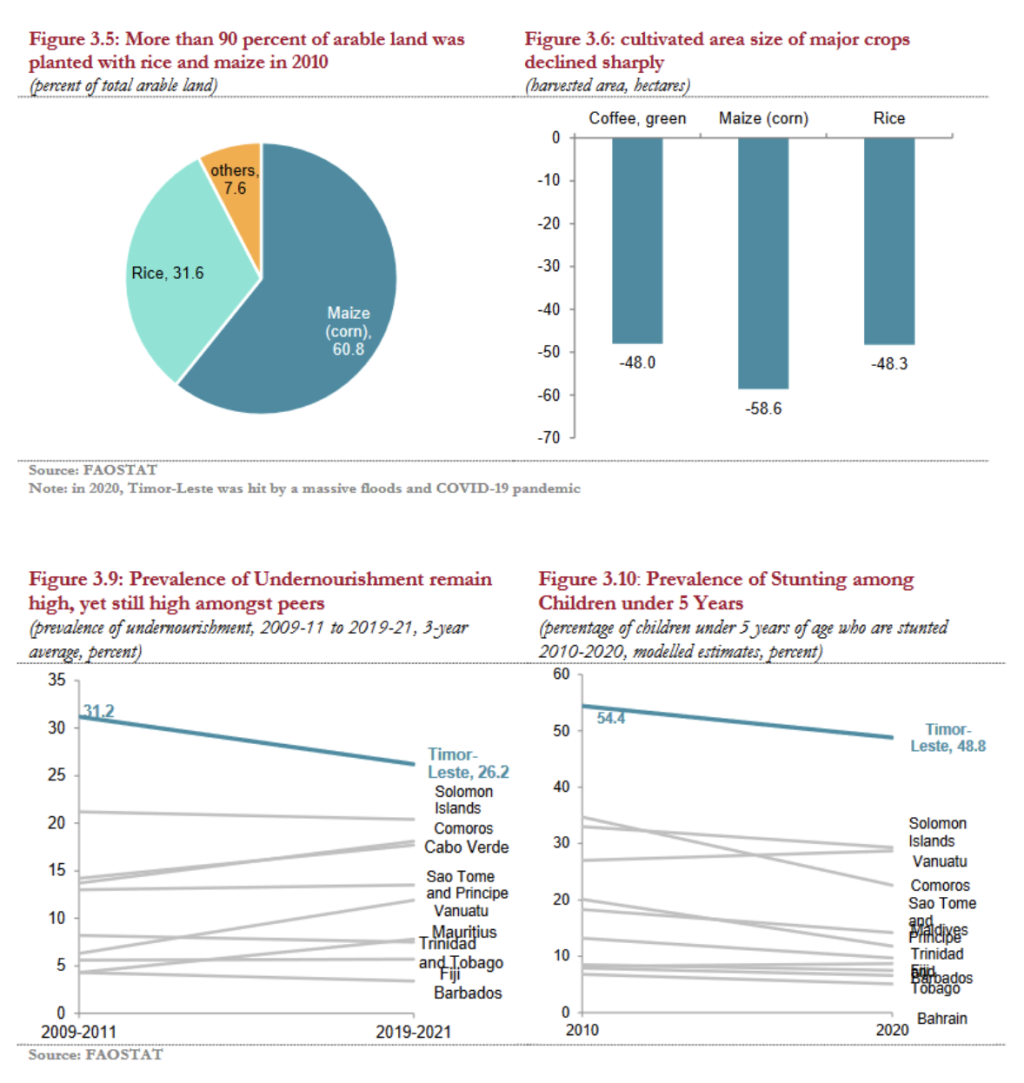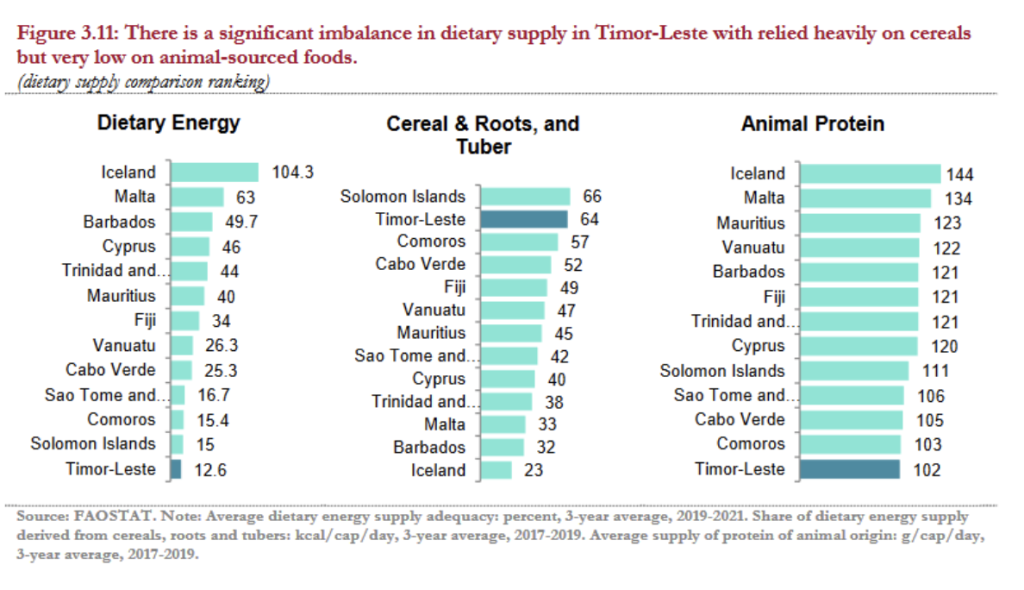Highlights on food insecurity, malnutrition, agricultural production, and related policy recommendations:
Food Insecurity
Despite a significant drop since last year, commodity prices remain higher than their pre-pandemic levels, impacting food security. The surge in prices after Russia’s invasion of Ukraine has largely been unwound on a combination of slowing economic activity, favorable winter weather, and a global reallocation of commodity trade flows. Nonetheless, prices of all major commodity groups and about four fifths of individual commodities remain above their 2015-19 average levels. Fertilizer prices reached an all-time high in real terms in 2022, while the food price index reached its second-highest level in real terms. The surge has contributed to higher consumer prices across the globe. The World Food Program estimates that 345 million people will face acute food insecurity.
Despite improvements in recent years, compared with other SIEs, the status of food security in Timor Leste remains weak. Some indicators still show significant challenges in undernourishment and stunting. Timor-Leste continues to face a high prevalence of undernourishment, with a rate of 26.2% in 2019-21 (Figure 4). This figure is not only concerning in itself but also higher compared to other small island economies (SIEs). The persistently high levels of undernourishment highlight the need for targeted interventions and strategies to improve access to nutritious food and address the underlying causes of food insecurity.
Malnutrition
Stunting rate in under-5 children is considerably high. The prevalence of stunting as the indicator of child malnutrition among children under the age of five was alarmingly high at 48.8% in 2020 (Figure 3.8). This figure ranks Timor-Leste with the highest prevalence of stunting among SIEs and considerably high as per WHO cut-off values for public health significance. The long-term consequences of stunting on children’s physical and cognitive development emphasize the urgency of implementing comprehensive nutrition programs and promoting adequate infant and young child feeding practices.
Despite the challenging food security situation, Timor-Leste has made significant progress in reducing undernourishment and stunting over the past decade. The prevalence of undernourishment has declined from 31.2% to 26.2%, indicating an encouraging trend towards improving access to food and addressing malnutrition. Similarly, the prevalence of stunting has also shown a notable reduction from 54.4% to 48.8% (Figure 3.10). These achievements demonstrate the potential for further advancements through sustained efforts and targeted interventions to ensure better nutrition outcomes for the population.
The significant imbalance in dietary supply is also highlighted in Timor-Leste. This dietary imbalance is characterized by a heavy reliance on cereals and a low consumption of animal-sourced foods (Figure 3.9). The findings shed light on the dietary adequacy and prevailing sources of nutrients across small island economies (SIEs), particularly in Timor-Leste.
When examining the ranking of dietary energy supply among SIEs, Timor-Leste stands at the lowest position (Figure 3.9). This indicates that, compared to other countries in the same category, the available food supply in Timor-Leste is the least adequate to meet the dietary needs of the population. This suggests a pressing need for interventions and strategies to improve the availability and accessibility of a diverse range of nutritious foods in Timor-Leste.
Nutrient source disparities, with cereal dominance and limited animal protein intake is seen in Timor-Leste. Furthermore, the data reveals notable differences in the sources of nutrients between Timor-Leste and other SIEs. In terms of nutrients provided from cereals, roots, and tubers, Timor-Leste ranks among the top SIEs (Figure 3.11). However, in terms of proteins of animal origin, Timor-Leste is positioned at the bottom of the ranking. This indicates a limited consumption of animal-sourced foods, which are important sources of essential nutrients such as protein.
Agriculture
Timor-Leste faces a scarcity of arable land suitable for agricultural production that hinders agricultural development. The country’s mountainous terrain and rugged landscape limit the availability of flat and fertile land, which is essential for cultivating crops. Timor-Leste arable land was at 7.5 percent of total land area in 2020, lower than the average EAP countries at 9.5 percent yet higher than Pacific Island countries at 2.4 percent. The scarcity of arable land poses a significant constraint on expanding agricultural activities and hampers efforts to increase food production and agricultural output.
Water availability is a significant binding constraint for agriculture in Timor-Leste, ranking lower compared to other agriculture-based countries. With limited access to sufficient and reliable water resources, agriculture is primarily dependent on rainfall, which is sparse and getting erratic, and it contributes to the poor performance in the sector. The country’s low water availability per capita, seasonal variations in rainfall, and inadequate irrigation coverage pose challenges for crop cultivation. Insufficient water affects crop yields, leading to decreased agricultural output and income for farmers. At 6.5 cubic meters per capita of internal renewable water resources in 2018, Timor-Leste ranks 63 out of 180, which is considerably lower than countries in a similar context, such as Indonesia, Myanmar, and Laos, who for example, have 7.5, 18.7, and 27 cubic meters per capita for the same period, in respectively.
The agriculture production has been declining substantially over the last decade, in part resulting from a decrease of cultivated land size. The value added of agriculture sector has been declining, lowered by 5 percent between 2021 and 2010. Compared to other sectors, the agriculture sector has been consistently one of the sectors with lower production in ten years (Figure 3.3). In part, this figure could be associated with the decline of harvested area in Timor-Leste. Between the 5-year period of 2001-2005 and the more recent 2016-2020 average, the average harvested area has significantly reduced by 35% (Figure 3.4).
Significant changes in crop area and production in Timor-Leste resulted in notable trends and implications for agricultural outcomes. Rice and Maize are two of the largest cereal commodities in Timor-Leste and over 92 % of arable crop land in 2010 was devoted to production of these two commodities (Figure 3.5). In a decade, there has been substantial reductions in the areas dedicated to rice, which decreased approximately by 48 percent between 2020 and 2010, and maize, which decreased by nearly 59 percent for the same period (Figure 3.6). In 2021, due to COVID related reverse migration to rural areas, the arable crop land increased substantially (from 29,081 ha in 2020 to 57,666 ha in 2021 for maize and from 18,912 ha in 2020 to 26,791 ha in 2021 for rice) for a single year. However, 2021 is likely to be an exception and the trend of long-term decline of arable crop land poses a serious challenge for agricultural sector in Timor Leste.
Over the past decade, Timor-Leste has experienced a significant surge in per capita food imports. Timor-Leste’s import value per capita was more than tripling from $63 in 2013 to $191 in 2022. A striking observation is the narrowing gap between Timor-Leste and other Small Island Economies (SIEs) in terms of per capita food imports. In 2013, Timor-Leste’s per capita food imports were nearly 10 times smaller compared to other SIEs ($688 vs. $63 per capita). However, by 2022, this ratio reduced to approximately four times smaller ($720 vs. $191 per capita).
Policy recommendations
3.4. Policy Recommendation
- Importance of Developing the Agricultural Sector in Timor-Leste.
The escalating per capita food imports and the closing gap between Timor-Leste and other SIEs highlight the critical importance of developing the agricultural sector in Timor-Leste. By prioritizing initiatives that promote domestic food production, improve productivity, and invest in value-added agricultural products, Timor-Leste can work towards reducing the dependency on imports, enhancing food security, and boosting economic resilience.
- Improving farmer incomes as the priority focus, especially through making small-scale agriculture more productive and remunerative.
The core reason for the decline in agriculture is the low incomes received by farmers, compared to alternative incomes in Dili or as overseas workers. The only way to reverse this trend is by improving farmer incomes through improved productivity. The improvements in incomes come from a change in the mix of commodities, along with productivity gains produced by improved use of inputs and technologies.
- Reduce growing mismatch between demand and domestic supply in key food categories.
It will be useful to reverse if possible the trend towards greater import dependency, especially with regard to cereals and livestock products.
- Moving from Cereals to High Value Commodities.
The obvious trends in commodity mix over recent years are away from cereals and towards selected animal production, vitamin-rich vegetables, fruits and legumes. These all offer higher incomes / return to labour, as well as delivering greater nutritional benefits. However, production of most of these commodities is still low and growing slowly, a cause of undernutrition and over-reliance on imported foods. Policies can be put in place to support this shift in the commodity mix.
- Emphasizing Productivity improvements.
As noted, there has been minimal improvement in yields for most crops over the past 10 years. However, there are exceptions, with some farmers discovering sizeable productivity gains through improved seed varieties, adopting low-cost technologies, use of inputs including fertilizer and herbicides, use of better storage, and other innovations. These gains can be shared more widely by investing in targeted extension services, policies and programs that improve the supply of inputs and address farmer credit constraints and risk aversion.
- Support development of food processing, especially through MSMEs where possible.
This will increase agriculture value-addition in the post-production phase, generate more stable and remunerative jobs in the agri-food sector as well as serve the growing domestic demand which is currently met through rising imports.




| Year of publication | |
| Geographic coverage | East Timor |
| Originally published | 05 Jul 2023 |
| Related organisation(s) | World Bank |
| Knowledge service | Metadata | Global Food and Nutrition Security | Food security and food crises | Access to foodSmallholder agriculture |
| Digital Europa Thesaurus (DET) | economic analysispolicymakinginflationpovertyagricultural productionfiscal policyprice of agricultural producewar in Ukrainemalnutrition |
